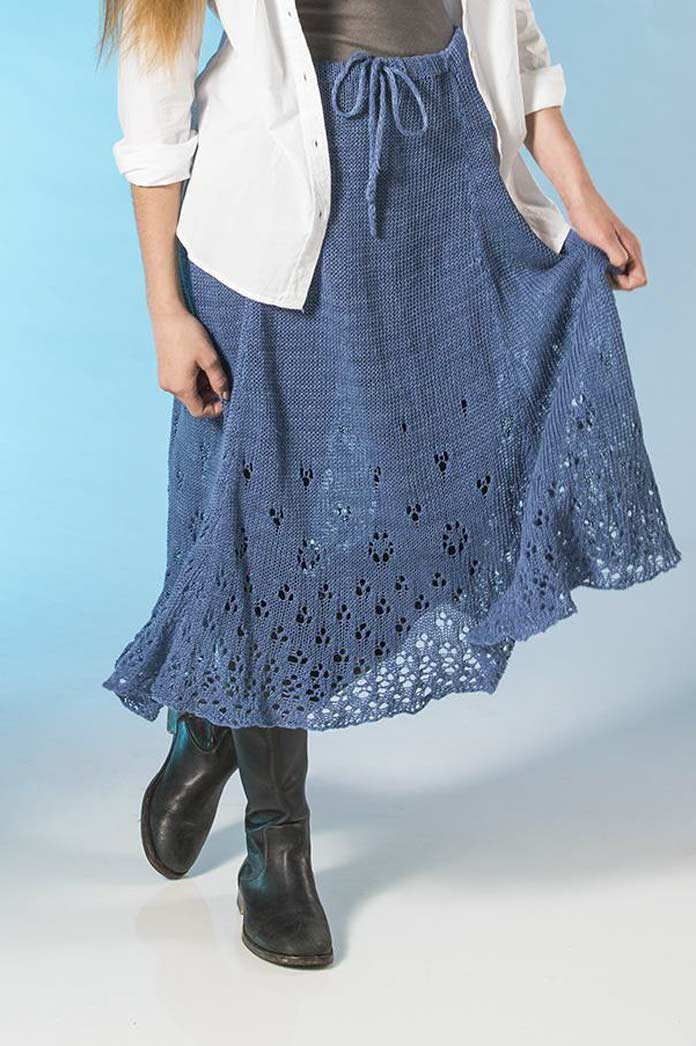Welcome back to my knitting of the Eyelet Skirt in Fibra Natura FLAX – a perfect skirt for summer! Yesterday, I talked about the yarn, and what working with Fibra Natura FLAX is like. Today is all about the pattern.

The Eyelet Skirt pattern using Fibra Natura FLAX yarn in Adriatic colorway
The first thing I did was read through the whole pattern—all of it. I can’t count the number of times I started a pattern, only to get surprised or confused by something, because I didn’t read through the pattern in the beginning!
As written, the Eyelet Skirt pattern is knit in four flat panels that are seamed together with the mattress stitch. Three of these panels are identical, the fourth panel has the opening at the waist for the drawstring cord, but the rest of the fourth panel is identical. I decided that instead of trying to mattress stitch all these panels together, especially because the hem is folded over and bound in place before the panels are sewn together, I’d just save myself some trouble and knit the skirt in the round.
If you convert a project from knit flat to work in the round, it’s even more important to look through the entire pattern before you start.
First, I looked at the lace charts.

Charts for the Eyelet Skirt knitting pattern

The lace pattern on the Eyelet Skirt
For each chart, all the lace was worked on the right side of the fabric, with wrong side rows being plain purl rows. This is immensely useful. Working the skirt in the round means that every row – now round – is a right-side round, and if there was any lace or shaping on the wrong side, I’d have to go through and figure out the equivalent stitches. Not having to do that makes this process a lot easier!
I also took a look at where the decrease rows fell. They all fell on odd-numbered right-side rows, so again, that made my life a lot easier.
Finally, I noticed the pattern had instructions for a selvedge stitch on each panel. Since these are stitches you use to seam the panels, they don’t count toward the finished sizing of the skirt. You lose either half of each selvedge stitch or the whole selvedge stitch, (depending on where you choose to place your seaming), from the final width of the skirt. So, one of the questions when converting a pattern from knit flat to in-the-round is: do you keep the selvedge stitches in or not?
I chose to keep them. Having a few extra selvedge stitches won’t make that much of a difference in sizing – 8 extra stitches at this tension (6 stitches per inch) is an extra 1¼” over the full width of the skirt. But, a) I like fuller skirts, and b) the waist drawstring is what will control the waist width once the pattern is all finished and washed so, an extra 1¼” there won’t make a difference.
Also, I know myself. If I didn’t include those stitches, I’d have to subtract two from my stitch counts. I know that if I forgot to do that, I’d wonder why my stitch counts were off. I’m stopping that problem before it starts.
Each panel for size small has a cast on of 84 stitches, so I cast on 4 sets of 84 stitches, separating them with the very handy UNIQUE Knitting Split Ring Markers. This worked out to 336 stitches on my Clover 4mm bamboo circular knitting needles. There were a lot of stitches to put on my 24” circular needles, but it worked out in the end! To make the long tail cast on more bearable, I cast on using two strands, one strand of yarn from the center of my yarn ball, and one strand of yarn from the outside of the same ball so I didn’t have to estimate how much of a tail I needed for the cast on.

Casting on using Fibra Natura FLAX in Adriatic, Clover Bamboo Circular Needles and UNIQUE Knitting Split Ring Stitch Markers
After that, I just followed the instructions for each panel except, instead of working one panel at a time, I worked all four panels at once while reading the instructions for each row.
The hardest part of this pattern was matching the lace pattern to the decrease rows, as both happen at the same time. I think most knitters get a bit panicked when they see “at the same time” as an instruction in a knitting pattern. But I promise, it’s not as hard as people often think.
Check out tomorrow’s post for how I handled that part of the instructions as we continue into the most complex part of the Eyelet Skirt pattern using Fibra Natura FLAX yarn in the beautiful Adriatic colorway.
This is part 2 of 5 in this series
Go back to part 1: Yarn Review: Fibra Natura FLAX for Summer Knitting!
Go to part 3: How to work ‘At the Same Time’ instructions in knitting patterns
